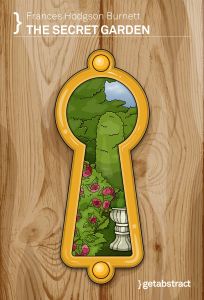
The Secret Garden
- Children´s Literature
- Modernism
What It’s About
A Return to the Garden
On its surface, The Secret Garden is a straightforward story of how an isolated orphan, by a lucky twist of fate, finds friendship and happiness in an unlikely way. But Frances Hodgson Burnett’s orphan – the decidedly unlikable and unattractive but refreshingly honest Mary Lennox is hardly the idealized heroine found in most turn-of-the-century orphan stories. Nor is the novel’s exploration of isolation, death, and the ways the traumas of the past haunt the present, typical children’s fare. And yet, it is precisely Burnett’s willingness to take her readers into the darkness – in order that they might better understand the path toward the light – which makes The Secret Garden such a compelling, modern-feeling tale today, more than 100 years after its publication. Burnett’s Eden-esque garden acts as both the site and symbol of her characters’ physical and spiritual growth. In nurturing the garden, the once physically and spiritually weak Mary – and her mirror, Colin – enact their own redemption: achieving health and happiness. Both a celebration of the natural world and an expression of faith in the possibility that even the most wounded soul can heal and transform, The Secret Garden offers an ahead-of-its-time understanding of the link between mental and physical well-being.
Summary
About the Author
Frances Eliza Hodgson Burnett was born on November 24, 1849 in Manchester, England. Hodgson was a bright, imaginative child, who enjoyed writing and telling stories from a young age. When her father, Edwin Hodgson, died, it left Burnett, her mother, Eliza, and her four siblings in reduced financial circumstances, and so Eliza’s brother invited them to join him in Knoxville, Tennessee. There, in order to help her impoverished family, Burnett began writing stories for magazines. Her first publication was in Godey’s Lady’s Book in 1868. She soon became a regular contributor to that publication, as well as to Scribner’s Monthly and Harper’s Bazaar. Burnett worked tirelessly and, by 1869 was earning a good living with her pen. In 1873, Burnett married Swan Burnett – an American medical student. She gave birth to their first child, Lionel, the following year. The family lived in Paris until their second son, Vivian was born. They then moved to Washington, D.C. so Swan could begin his medical practice. Burnett’s time in D.C. opened her up to new ideas – including the “New Thought” movement’s belief in the power of positive thinking – which would influence her later writings. Her first novel, That Lass o’ Lowrie’s, received good reviews and others soon followed. Burnett’s play, Esmerelda (1881), became the 19th century’s longest-running Broadway production. She began writing children’s literature in the early 1880s, but it was not until 1884, with the publication of the international bestseller, Little Lord Fauntleroy, that Burnett became a name within that genre. From 1887 onward, Burnett began spending more time in England, away from her family. She wrote a number of plays and stories during this time, including Sara Crewe (1888), which she would, eventually, expand into the children’s novel, A Little Princess (1905). Lionel’s death from tuberculosis in 1890 affected Burnett deeply and sparked a greater interest in the New Thought movement and related beliefs. She found the greatest peace at Great Maytham Hall in England, where she cultivated the large garden that served as her inspiration for The Secret Garden (1911). In 1898, Frances divorced Burnett and, rather reluctantly, married a young actor named Stephen Townsend. She regretted the marriage immediately, and it was over by 1902. In 1907, Frances moved to Long Island, New York, where she lived until her death on October 29, 1924.









Comment on this summary